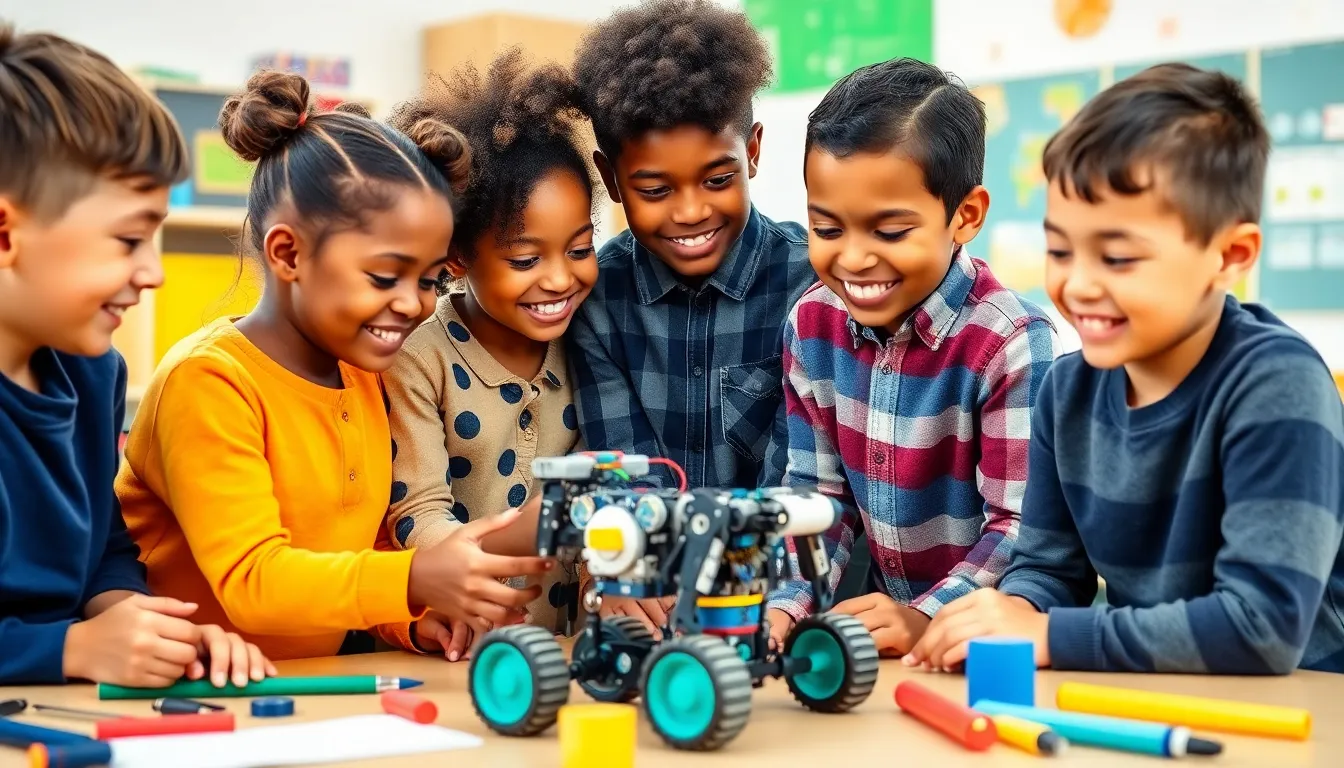In a world where robots might soon take over the kitchen, equipping kids with STEM skills is more important than ever. Science, Technology, Engineering, and Mathematics aren’t just subjects—they’re the building blocks of future innovators. Imagine your child not only mastering math but also designing their own video games or building a robot that might just serve them snacks.
Table of Contents
ToggleWhat Is a STEM Program for Kids?
A STEM program for kids focuses on fostering skills in Science, Technology, Engineering, and Mathematics. Kids engage in hands-on activities that stimulate creativity and critical thinking. These programs help children understand and apply fundamental concepts in real-world situations.
Educational institutions often implement STEM programs in response to emerging job markets. Classes may include robotics, coding, environmental science, and mathematics challenges. Programs encourage collaboration among students, enhancing social skills while building teamwork experience.
Children involved in STEM programs exhibit improved problem-solving abilities. They learn to approach challenges with innovative solutions. For instance, creating a simple video game offers both coding skills and design principles. Building a robot teaches engineering concepts alongside programming logic.
Statistics reveal that STEM skills significantly increase job opportunities in the future workforce. Government and private organizations endorse these programs to prepare youth for various careers. Parents recognize the long-term benefits as they observe their children’s evolving interest in technology and science. Cost-effective options like community workshops and online resources make these programs accessible to a wider audience.
Participants often experience lasting interest in STEM fields, leading to higher educational achievement. Various organizations also provide competitions that motivate students to excel. STEM programs cultivate a generation poised to lead advancements in technology and innovation.
Benefits of STEM Programs

STEM programs offer numerous benefits for children, contributing to their development and future success. These initiatives cultivate essential skills that empower kids in various ways.
Enhancing Critical Thinking
Critical thinking skills emerge as children engage in problem-solving activities within STEM programs. They analyze information systematically and evaluate different solutions. For instance, when tasked with designing a robot, kids must consider various components and functionalities. This hands-on experience encourages them to think logically and make informed decisions. Statistics show that students who participate in STEM activities demonstrate better reasoning abilities compared to their peers. Over time, these critical thinking skills facilitate more effective learning across all academic subjects.
Fostering Creativity
Creativity flourishes in STEM environments as children explore new ideas and innovate solutions. They not only engage in coding but also express themselves through design and storytelling. For example, creating a video game allows them to craft narratives while developing technical skills. Such programs encourage experimentation. Kids learn that failure leads to learning opportunities. Research indicates that fostering creativity enhances motivation to learn and results in long-term interest in STEM fields. Ultimately, this combination of creativity and technical skills prepares children for diverse challenges in the future.
Types of STEM Programs Available
Various types of STEM programs cater to children’s diverse interests. Each program fosters unique skills and encourages a love for learning.
Robotics and Coding
Robotics programs introduce children to the basic principles of mechanics and electronics. Participants build and program robots, enhancing problem-solving and critical thinking skills. Coding classes complement this by teaching children programming languages, which enable them to create games and apps. Engaging in these activities boosts creativity and teamwork as kids collaborate on projects.
Science and Nature
Children explore science through hands-on experiments and nature activities in dedicated programs. These lessons often cover topics such as biology, physics, and environmental science, bringing theoretical concepts to life. By investigating ecosystems or conducting simple experiments, kids gain a deeper understanding of the natural world. Programs focusing on science also encourage curiosity and observational skills, nurturing future scientists.
Mathematics and Engineering
Mathematics and engineering programs center on developing computational skills through real-world applications. Activities may include building structures or solving engineering challenges, which reinforces math concepts. Students learn to apply mathematical principles while working on practical projects, sharpening their analytical abilities. Engaging in these areas promotes a strong foundation in both mathematics and engineering, vital for future success in STEM fields.
How to Choose the Right STEM Program
Choosing the right STEM program requires careful consideration of various factors. Parents must evaluate each program based on their child’s needs and interests.
Age Appropriateness
Age-appropriate STEM programs engage children effectively. Programs designed for younger audiences often focus on fundamental concepts through playful activities. Programs target older children, on the other hand, may delve into complex subjects like robotics and coding. Understanding developmental stages ensures that activities suit the child’s cognitive and emotional maturity. For example, a program for preschoolers might emphasize basic science through outdoor exploration, while middle school curricula often introduce concepts like engineering design challenges. Parents should align program content with their child’s age to maximize learning engagement.
Learning Objectives
Learning objectives significantly shape the structure of a STEM program. Each program should define clear goals that promote critical thinking and problem-solving skills. For example, some programs aim to enhance coding proficiency, while others focus on building teamwork through collaborative projects. Programs that incorporate hands-on experiences foster deeper understanding by allowing children to explore concepts in real-world contexts. Parents should assess whether the program inspires critical thinking, creativity, and a curiosity for exploration. Selecting a program that aligns with these learning objectives enhances a child’s educational journey in STEM fields.
STEM programs for kids are more than just educational activities; they’re gateways to a future filled with possibilities. By engaging children in hands-on experiences that blend creativity with critical thinking, these programs equip them with essential skills for tomorrow’s job market.
As kids explore robotics, coding, and science, they not only develop problem-solving abilities but also ignite a passion for learning. Parents have the opportunity to guide their children towards programs that align with their interests, ensuring a fulfilling and enriching experience.
Ultimately, investing in STEM education today lays the groundwork for a generation ready to tackle the challenges of the future and drive innovation across various fields.









